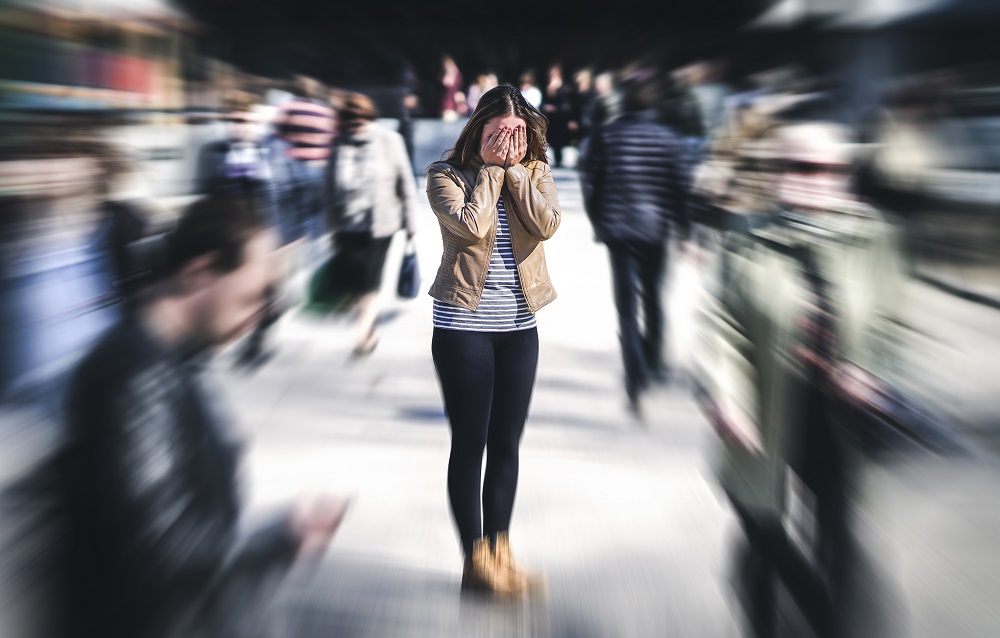
Lots of us can experience panic attacks at different times in our lives: what are the symptoms and what can we do if we have a panic attack?
A panic attack is a sudden onset of intense anxiety or terror without any obvious threat. It is a misfiring of the so-called “fight, flight or freeze” adrenaline reaction.
Dr Michael McDonough, Consultant Psychiatrist and head of our Anxiety Disorders Service, spoke about panic attacks on RTÉ Radio 1's John Murray Show.
You can listen back to Dr McDonough talking about panic attacks, or find helpful information about the symptoms of panic attacks and how you can deal with panic below.
What are typical symptoms of panic attacks?
Panic attacks can include usually four or more of the following:
- pounding heart
- sweating
- shaking
- an out of body or unreal feeling
- shivers or hot flushes
- pins and needles
- shortness of breath, which can include:
- a feeling of choking
- chest pain
- nausea, or tummy cramps
- feeling dizzy or unsteady.
Panic attacks can be full-blown or milder “near” panics, and they usually build to a peak, or crescendo, in 10 minutes. Often, the person understandably makes a catastrophic interpretation of what’s happening, such as:
- “I feel dizzy - I will faint”
- “I feel like I’m not really here - I’m going mad”
- “I can’t breathe properly - I’m going to suffocate”.
Panic attacks burn out after several minutes, but lingering effects may last hours.
Do panic attack symptoms vary?
The physical symptoms tend to be much the same, but the focus of fear tends to vary for different people. Some people fear collapsing, others a heart attack, or others a feeling of losing control.
Trigger situations that provoke the panics can vary also, such as:
- fear of being far from home - agoraphobia
- night time panics
- confined spaces
- worry-induced panic
- panic triggered by trauma memories.
What might a panic attack feel like?
An example of a person going though a typical agoraphobic panic might look something like the sequence below:
Get on train – feel wary of getting trapped or stuck – start to feel tense, sweaty – try to calm down – stand near the exit – hold on to something to be more steady, which reinforces the idea that something bad is on the way – train stops between stations – feel trapped – try to catch breath - breathe rapidly, which brings dizziness – feel fear of fainting – feel unreal – feel intense terror – fear of dying – leave at next station.
How do you know it is a panic attack?
Looking at the symptoms and the fact that the main sensation is fear is a way of being able to tell you are having a panic attack and not something that has a physical cause.
A few medical problems can mimic panic, but the signs of the medical problem are usually fairly obvious. Common examples are:
- overactive thyroid or adrenal gland
- certain kinds of seizures
- heart palpitations
- lung problems, like asthma.
Most people suspect a medical cause with their first panic and go to Accident and Emergency (A&E) in their local hospital or to their GP.
Some people are misdiagnosed has having a medical or heart problem, though there is more awareness of panic now than there used to be.
Can panic attacks be a symptom of another mental health problem?
Panic attacks can be a sign of another mental health difficulty. Less than half of people have isolated so-called panic disorder.
Panics often accompany depression and, if mood and energy is low, this should be considered as a possible underlying cause. When we are down, we tend to be more anxious and more vulnerable to panic feelings.
Panic may also be a sign of another anxiety disorder, such as:
- social anxiety
- obsessive-compulsive disorder
- a phobia
- post-traumatic stress disorder (PTSD).
50% develop agoraphobia, a fear of being away from safety usually home.
For one third of people, panic is mixed with alcohol or drug misuse.
How common are panic attacks?
Panic attacks are very common. Between 7% and 9% of the population experience panic attacks, and twice this amount if milder panics are included.
Who is more likely to have panic attacks?
Panic attacks are more common in women, with a ratio of 3:2.
Most panic problems start from the late teens to the early 20s, but they can occur at any age.
Panic attacks are often associated with stressful events, life upheavals or traumas, either past or present such as:
- loss of employment
- being widowed or separated
- early life adversity or abuse.
What is the best way to deal with a panic attack?
Breathing and relaxation training is no longer considered the best approach. They tend to subtly maintain the idea that panic is dangerous or life-threatening.
We now recommend for a typical panic to “go with it”.
This is similar to the meditational idea of “detached acceptance”. Test out whether the panic will really harm you by riding it out. Stay in the situation if you can, until the panic subsides. Learn that, although very unpleasant, panic isn’t dangerous and won’t cause lasting harm.
However, each person is different. If panic is linked with another problem, like past trauma, abandonment feelings or depression, then it may not be best to tough it out. A more compassionate therapeutic approach may be needed initially. This highlights the importance of a careful assessment.
When should you seek expert help for panic?
If panics are causing significant disruption to your life, they should be addressed early - the earlier the better.
A brief, focused therapy using Cognitive Behavioural Therapy (CBT) aims to break the maintenance cycle and is very effective for typical panic. It usually takes four to 10 sessions.
But, as mentioned earlier, it is important to note that panic can indicate a more complex, underlying problem, so a careful mental health assessment is needed to start with.
What is panic disorder?
Panic disorder may be diagnosed when there are recurrent panics that disrupt a person’s life. Once someone has one panic attack, they understandably fear another will happen, which can often generate new episodes.
What types of treatment for panic are there?
Good psychotherapy is the preferred treatment for most people experiencing panic. Some people require longer-term therapies to address underlying problems with confidence, relationships or past traumas. This long-term therapy tends to be taken on by therapists with a different training to the standard CBT therapy mentioned before.
Sometimes, serotonin-boosting antidepressants are used, especially if depression is present. Valium-like sedatives are best avoided.
It is important to note also that some people have addictions to alcohol or sedative drugs, and that panics are a symptom of drug or alcohol withdrawal. These people would need their addiction addressed first.



